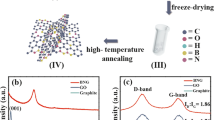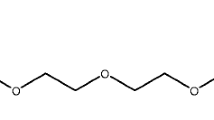Abstract
The narrow operating potential range is the main obstacle to limit the increase of energy density of supercapacitors. Surface functionalization of carbon-based electrode materials can effectively improve their electrochemical properties. In this work, a series of ionic liquid (ILs)/graphene composite electrode materials were designed and prepared using covalent and non-covalent strategies. The effects of ionic liquid modification on extending the operating voltage window, restraining self-discharge and optimizing the cycle life of devices were comprehensively studied. As a result, the non-covalent modification method can effectively reduce the defect degree of the electrodes without influencing their porosity. Meanwhile, the wettability of ILs/graphene with ILs electrolytes is improved and the self-discharge effect of the electrodes is suppressed. The resulting supercapacitors exhibited excellent stability at 4.0 V for 10,000 cycles with energy densities reaching up to 65 Wh kg–1.




Similar content being viewed by others
Data availability
The authors confirm that they have known the research data policy, and the data are available.
References
A. Muzaffar, M.B. Ahamed, K. Deshmukh, J. Thirumalai, A review on recent advances in hybrid supercapacitors: design, fabrication and applications. Renew. Sust. Energ. Rev. 101, 123–145 (2019). https://doi.org/10.1016/j.rser.2018.10.026
T.Y. Kim, H.W. Lee, M. Stoller, D.R. Dreyer, C.W. Bielawski, R.S. Ruoff, K.S. Suh, High-performance supercapacitors based on poly (ionic liquid)-modified graphene electrodes. ACS Nano 5, 436–442 (2011). https://doi.org/10.1021/nn101968p
J. Yan, Q. Wang, T. Wei, Z. Fan, Recent advances in design and fabrication of electrochemical supercapacitors with high energy densities. Adv. Energy Mater. 4, 1300816 (2014). https://doi.org/10.1002/aenm.201300816
G. Hernández, M. Işik, D. Mantione, A. Pendashteh, P. Navalpotro, D. Shanmukaraj, R. Marcilla, D. Mecerreyes, Redox-active poly (ionic liquid) s as active materials for energy storage applications. J. Mater. Chem. A. 5, 16231–16240 (2017). https://doi.org/10.1039/C6TA10056B
K.L. Van Aken, M. Beidaghi, Y. Gogotsi, Formulation of ionic-liquid electrolyte to expand the voltage window of supercapacitors. Angew. Chem. Int. Ed. 127, 4888–4891 (2015). https://doi.org/10.1002/ange.201412257
S. Pan, M. Yao, J. Zhang, B. Li, C. Xing, X. Song, P. Su, H. Zhang, Recognition of ionic liquids as high-voltage electrolytes for supercapacitors. Front. Chem. 8, 261 (2020). https://doi.org/10.3389/fchem.2020.00261
A. Lewandowski, A. Olejniczak, M. Galinski, I. Stepniak, Performance of carbon–carbon supercapacitors based on organic, aqueous and ionic liquid electrolytes. J. Power Sour. 195, 5814–5819 (2010). https://doi.org/10.1016/j.jpowsour.2010.03.082
D.R. MacFarlane, M. Forsyth, P.C. Howlett, M. Kar, S. Passerini, J.M. Pringle, H. Ohno, M. Watanabe, F. Yan, W. Zheng, Ionic liquids and their solid-state analogues as materials for energy generation and storage. Nat. Rev. Mater. 1, 1–15 (2016). https://doi.org/10.1038/natrevmats.2015.5
J. Zheng, N. Qin, L. Jin, X. Guo, C. Shen, Q. Wu, J.P. Zheng, Constructing an unbalanced structure toward high working voltage for improving energy density of non-aqueous carbon-based electrochemical capacitors. Chinese Chem. Lett. 31, 903–908 (2020). https://doi.org/10.1016/j.cclet.2019.09.048
J. Zheng, S.S. Moganty, P.C. Goonetilleke, R.E. Baltus, D. Roy, A comparative study of the electrochemical characteristics of [Emim+][BF4−] and [Bmim+][BF4−] ionic liquids at the surfaces of carbon nanotube and glassy carbon electrodes. J. Phys. Chem. C 115, 7527–7537 (2011). https://doi.org/10.1021/jp1123162
P. Yang, Y. Ding, Z. Lin, Z. Chen, Y. Li, P. Qiang, M. Ebrahimi, W. Mai, C.P. Wong, Z.L. Wang, Low-cost high-performance solid-state asymmetric supercapacitors based on MnO2 nanowires and Fe2O3 nanotubes. Nano Lett. 14, 731–736 (2014). https://doi.org/10.1021/nl404008e
J. Gamby, P.L. Taberna, P. Simon, J.F. Fauvarque, M. Chesneau, Studies and characterisations of various activated carbons used for carbon/carbon supercapacitors. J. Power Sour. 101, 109–116 (2001). https://doi.org/10.1016/S0378-7753(01)00707-8
P. Liu, M. Verbrugge, S. Soukiazian, Influence of temperature and electrolyte on the performance of activated-carbon supercapacitors. J. Power. Sources 156, 712–718 (2006). https://doi.org/10.1016/j.jpowsour.2005.05.055
E. Raymundo-Pinero, K. Kierzek, J. Machnikowski, F. Béguin, Relationship between the nanoporous texture of activated carbons and their capacitance properties in different electrolytes. Carbon 44, 2498–2507 (2006). https://doi.org/10.1016/j.carbon.2006.05.022
O. Barbieri, M. Hahn, A. Herzog, R. Kötz, Capacitance limits of high surface area activated carbons for double layer capacitors. Carbon 43, 1303–1310 (2005). https://doi.org/10.1016/j.carbon.2005.01.001
K. Kierzek, E. Frackowiak, G. Lota, G. Gryglewicz, J. Machnikowski, Electrochemical capacitors based on highly porous carbons prepared by KOH activation. Electrochim. Acta 49, 515–523 (2004). https://doi.org/10.1016/j.electacta.2003.08.026
Q.-Y. Li, Z.-S. Li, L. Lin, X.Y. Wang, Y.-F. Wang, C.-H. Zhang, H.-Q. Wang, Facile synthesis of activated carbon/carbon nanotubes compound for supercapacitor application. Chem. Eng. J. 156, 500–504 (2010). https://doi.org/10.1016/j.cej.2009.10.025
A.K. Geim, K.S. Novoselov, The rise of graphene. Nat. Mater. 6, 183–191 (2007). https://doi.org/10.1038/nmat1849
Y. Xu, K. Sheng, C. Li, G. Shi, Self-assembled graphene hydrogel via a one-step hydrothermal process. ACS Nano 4, 4324–4330 (2010). https://doi.org/10.1021/nn101187z
S. Shiraishi, H. Kurihara, K. Okabe, D. Hulicova, A. Oya, Electric double layer capacitance of highly pure single-walled carbon nanotubes (HiPco™ Buckytubes™) in propylene carbonate electrolytes. Electrochem. Commun. 4, 593–598 (2002). https://doi.org/10.1016/S1388-2481(02)00382-X
L.B. Ren, W. Hua, Z.D. Hou, J.G. Wang, Rational construction of CoP@C hollow structure for ultrafast and stable sodium energy storage. Rare Met. 41, 1859–1869 (2022). https://doi.org/10.1007/s12598-021-01930-x
J. Zhang, W. Lv, D. Zheng, Q. Liang, D.W. Wang, F. Kang, Q.H. Yang, The interplay of oxygen functional groups and folded texture in densified graphene electrodes for compact sodium-ion capacitors. Adv. Energy Mater. 8, 1702395 (2018). https://doi.org/10.1002/aenm.201702395
Z. She, D. Ghosh, M.A. Pope, Decorating graphene oxide with ionic liquid nanodroplets: an approach leading to energy-dense, high-voltage supercapacitors. ACS Nano 11, 10077–10087 (2017). https://doi.org/10.1021/acsnano.7b04467
S. Yang, X. Song, P. Zhang, J. Sun, L. Gao, Self-assembled α-Fe2O3 mesocrystals/graphene nanohybrid for enhanced electrochemical capacitors. Small 10, 2270–2279 (2014). https://doi.org/10.1002/smll.201303922
Y. Tao, X. Xie, W. Lv, D.-M. Tang, D. Kong, Z. Huang, H. Nishihara, T. Ishii, B. Li, D. Golberg, Towards ultrahigh volumetric capacitance: graphene derived highly dense but porous carbons for supercapacitors. Sci. Rep. 3, 2975 (2013). https://doi.org/10.1038/srep02975
L. Zhang, G. Shi, Preparation of highly conductive graphene hydrogels for fabricating supercapacitors with high rate capability. J. Phys. Chem. C 115, 17206–17212 (2011). https://doi.org/10.1021/jp204036a
Q. Wang, Y. Yun, Nonenzymatic sensor for hydrogen peroxide based on the electrodeposition of silver nanoparticles on poly (ionic liquid)-stabilized graphene sheets. Microchim. Acta 180, 261–268 (2013). https://doi.org/10.1007/s00604-012-0921-3
J. Yuan, M. Antonietti, Poly (ionic liquid)s: polymers expanding classical property profiles. Polymer 52, 1469–1482 (2011). https://doi.org/10.1016/j.polymer.2011.01.043
H. Mao, J. Liang, H. Zhang, Q. Pei, D. Liu, S. Wu, Y. Zhang, X.-M. Song, Poly (ionic liquids) functionalized polypyrrole/graphene oxide nanosheets for electrochemical sensor to detect dopamine in the presence of ascorbic acid. Biosens. Bioelectron. 70, 289–298 (2015). https://doi.org/10.1016/j.bios.2015.03.059
P. Wang, Y. Zheng, B. Li, Preparation and electrochemical properties of polypyrrole/graphite oxide composites with various feed ratios of pyrrole to graphite oxide. Synth. Met. 166, 33–39 (2013). https://doi.org/10.1016/j.synthmet.2013.01.002
F. Shi, Y. Deng, Abnormal FT-IR and FTRaman spectra of ionic liquids confined in nano-porous silica gel. Spectochim. Acta. A 62, 239–244 (2005). https://doi.org/10.1016/j.saa.2004.12.031
J. Zhang, P. Chen, B.H.L. Oh, M.B. Chan-Park, High capacitive performance of flexible and binder-free graphene–polypyrrole composite membrane based on in situ reduction of graphene oxide and self-assembly. Nanoscale 5, 9860–9866 (2013). https://doi.org/10.1039/C3NR02381H
T.T. Tung, T.Y. Kim, J.P. Shim, W.S. Yang, H. Kim, K.S. Suh, Poly (ionic liquid)-stabilized graphene sheets and their hybrid with poly (3, 4-ethylenedioxythiophene). Org. Electron. 12, 2215–2224 (2011). https://doi.org/10.1016/j.orgel.2011.09.012
L. Qiu, Y. Peng, B. Liu, B. Lin, Y. Peng, M.J. Malik, F. Yan, Polypyrrole nanotube-supported gold nanoparticles: an efficient electrocatalyst for oxygen reduction and catalytic reduction of 4-nitrophenol. Appl. Catal. A-Gen. 413, 230–237 (2012). https://doi.org/10.1016/j.apcata.2011.11.013
I. Carrillo, E.S. de la Blanca, J.L.G. Fierro, M.A. Raso, F. Acción, E. Enciso, M.I. Redondo, Conductivity and long term stability of polypyrrole poly (styrene-co-methacrylic acid) core–shell particles at different polypyrrole loadings. Thin Solid Films 539, 154–160 (2013). https://doi.org/10.1016/j.tsf.2013.05.086
S. Konwer, R. Boruah, S.K. Dolui, Studies on conducting polypyrrole/graphene oxide composites as supercapacitor electrode. J. Electron. Mater. 40, 2248–2255 (2011). https://doi.org/10.1007/s11664-011-1749-z
I.M. De la Fuente Salas, Y.N. Sudhakar, M. Selvakumar, High performance of symmetrical supercapacitor based on multilayer films of graphene oxide/polypyrrole electrodes. Appl. Surf. Sci. 296, 195–203 (2014). https://doi.org/10.1016/j.apsusc.2014.01.080
C. Kolbeck, N. Taccardi, N. Paape, P.S. Schulz, P. Wasserscheid, H.-P. Steinrück, F. Maier, Redox chemistry, solubility, and surface distribution of Pt (II) and Pt (IV) complexes dissolved in ionic liquids. J. Mol. Liq. 192, 103–113 (2014). https://doi.org/10.1016/j.molliq.2013.07.007
S. Carquigny, J.-B. Sanchez, F. Berger, B. Lakard, F. Lallemand, Ammonia gas sensor based on electrosynthesized polypyrrole films. Talanta 78, 199–206 (2009). https://doi.org/10.1016/j.talanta.2008.10.056
W. Jia, Y. Wu, J. Huang, Q. An, D. Xu, Y. Wu, F. Li, G. Li, Poly (ionic liquid) brush coated electrospun membrane: a useful platform for the development of functionalized membrane systems. J. Mater. Chem. 20, 8617–8623 (2010). https://doi.org/10.1039/C0JM01179G
S. Chebil, M.O. Monod, P. Fisicaro, Direct electrochemical synthesis and characterization of polypyrrole nano-and micro-snails. Electrochim. Acta 123, 527–534 (2014). https://doi.org/10.1016/j.electacta.2014.01.058
Y. Wei, L. Li, X. Yang, G. Pan, G. Yan, X. Yu, One-step UV-induced synthesis of polypyrrole/Ag nanocomposites at the water/ionic liquid interface. Nanoscale Res. Lett. 5, 433–437 (2010). https://doi.org/10.1007/s11671-009-9501-9
L.G. Cançado, A. Jorio, E.H. Martins Ferreira, F. Stavale, C.A. Achete, R.B. Capaz, M.V.O. Moutinho, A. Lombardo, T.S. Kulmala, A.C. Ferrari, Quantifying defects in graphene via Raman spectroscopy at different excitation energies. Nano Lett. 11, 3190–3196 (2011). https://doi.org/10.1021/nl201432g
W. Chen, X. Li, G. Xue, Z. Wang, W. Zou, Magnetic and conducting particles: preparation of polypyrrole layer on Fe3O4 nanospheres. Appl. Surf. Sci. 218, 216–222 (2003). https://doi.org/10.1016/S0169-4332(03)00590-7
S. Fountoulaki, V. Daikopoulou, P.L. Gkizis, I. Tamiolakis, G.S. Armatas, I.N. Lykakis, Mechanistic studies of the reduction of nitroarenes by NaBH4 or hydrosilanes catalyzed by supported gold nanoparticles. ACS Catal. 4, 3504–3511 (2014). https://doi.org/10.1021/cs500379u
A.S. Rewar, R.S. Bhavsar, K. Sreekumar, U.K. Kharul, Polybenzimidazole based polymeric ionic liquids (PILs): effects of controlled degree of N-quaternization on physical and gas permeation properties. J. Membr. Sci. 481, 19–27 (2015). https://doi.org/10.1016/j.memsci.2015.02.004
H. Wang, Q. Hao, X. Yang, L. Lu, X. Wang, A nanostructured graphene/polyaniline hybrid material for supercapacitors. Nanoscale 2, 2164–2170 (2010). https://doi.org/10.1039/C0NR00224K
L. Demarconnay, E. Raymundo-Piñero, F. Béguin, Adjustment of electrodes potential window in an asymmetric carbon/MnO2 supercapacitor. J. Power Sour. 196, 580–586 (2011). https://doi.org/10.1016/j.jpowsour.2010.06.013
R. Arunkumar, C.J. Drummond, T.L. Greaves, FTIR spectroscopic study of the secondary structure of globular proteins in aqueous protic ionic liquids. Front. Chem. 7, 74 (2019). https://doi.org/10.3389/fchem.2019.00074
K. Nomura, H. Nishihara, N. Kobayashi, T. Asada, T. Kyotani, 4.4 V supercapacitors based on super-stable mesoporous carbon sheet made of edge-free graphene walls. Energ. Environ. Sci. 12, 1542–1549 (2019). https://doi.org/10.1039/C8EE03184C
Funding
This work was supported by the National Natural Science Foundation of China (Grant No. 52102053), the Fundamental Research Program of Shanxi Province (Grant No. 20210302124655), the Natural Science Foundation of Shanxi Province (Grant No. 20210302123041), the Key Laboratory Research Foundation of North University of China (Grant No. 2022C80303), the Shanxi Key Laboratory of Advanced Carbon Electrode Materials (Grant No. 202104010910019).
Author information
Authors and Affiliations
Contributions
All the authors contributed to the completion of this paper. The details are as follows: (1) JK’s contributions included investigation, experiment implementation, data processing and analysis, and paper writing. (2) JL’s contributions included research ideas and investigation, paper revision, and providing funding and platforms for research. (3) RZ’s contributions were to revise the article. (4) CZ’s contributions were to assist the first author in the testing of the electrochemical impedance.
Corresponding author
Ethics declarations
Conflict of interest
The authors declare that they have no conflict of interest.
Ethical approval
This paper comply with ethical standards.
Additional information
Publisher's Note
Springer Nature remains neutral with regard to jurisdictional claims in published maps and institutional affiliations.
Supplementary Information
Below is the link to the electronic supplementary material.
Rights and permissions
Springer Nature or its licensor (e.g. a society or other partner) holds exclusive rights to this article under a publishing agreement with the author(s) or other rightsholder(s); author self-archiving of the accepted manuscript version of this article is solely governed by the terms of such publishing agreement and applicable law.
About this article
Cite this article
Kang, J., Zhang, C., Zhou, R. et al. The rational design of poly (inoic liquid) for 4.0 V graphene-based supercapacitors. J Mater Sci: Mater Electron 35, 165 (2024). https://doi.org/10.1007/s10854-023-11900-x
Received:
Accepted:
Published:
DOI: https://doi.org/10.1007/s10854-023-11900-x




